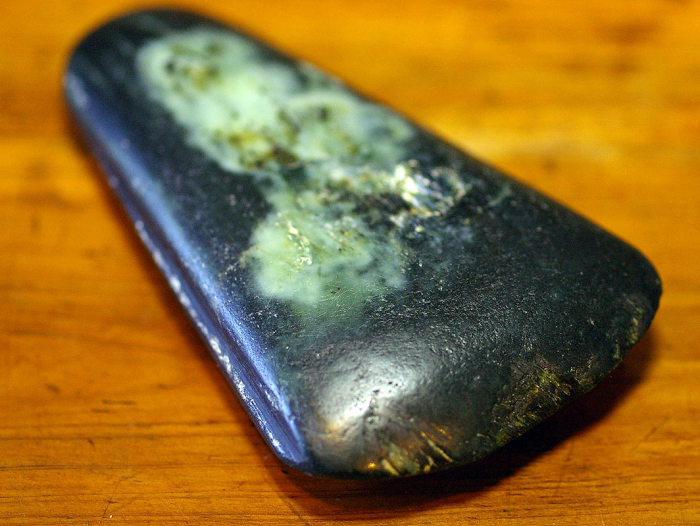Jade evolved from sacrificial ornament to status symbol

A jade axe
The state has two fundamental functions: balancing internal contradictions and fighting against external threats. Political institutions and military forces are two major tools for fulfilling these two functions, respectively. The fundamental political institution in ancient China was the etiquette system (li zhi) formed by integrating and upgrading the rites and etiquette originally developed for worshipping gods in antiquity.
The etiquette system is a symbol of authoritative power for maintaining social order. It encompasses the principles and conventions for regulating people’s thoughts and behavior as well as the means for standardizing social life.
Three elements are at the core of the ancient Chinese etiquette system—sacrifices to Heaven and Earth, sacrifices to ancestors and reverence for monarchical power. To ancient people, Heaven and Earth constituted the origin of mankind as well as the source of food and everyday needs. Ancestors were the origin of the monarch and his family members, and the monarch was the key to managing the country’s military, political, education and other affairs. The fundamental aim of offering sacrifices to Heaven, Earth and ancestors was to deify the monarchical powers.
Sacrifice to God
The Chinese character li is defined as “to offer sacrifice to God and pray for blessing” in Shuo Wen Jie Zi (Explanation on Chinese Characters), the first lexical work analyzing the shape of the characters and searching the source of characters systematically in ancient China, written by Xu Shen in the Eastern Han Dynasty (25-220). In primitive society, it was a solemn and devout rite to pray to God by offering sacrifice. One important sacrifice was jade.
Researchers believe that the nearly 100 excavated jade objects belonging to the Xinglongwa culture, a Neolithic culture in northeastern China, are the most ancient examples of jade artifacts in China. These objects were used about 4,600-8,000 years ago, when stone implements were still the major tools for production.
At that time, jade implements were thought to be of higher ranking than stone implements and more appealing to the eye. So they became one major offering to God.
Ancient people thought deities also performed work like humans, so they chose fine and colorful jade materials to make axes, adzes, knives, chisels and other instruments to offer deities. Therefore, jade implements served more as sacrificial ornaments than production tools.
Status symbols
Another use of jade in ancient China was to craft penannular jade rings. Penannular jade rings unearthed in Xinglongwa culture were worn by owners of tombs as earrings. However, they cannot be treated as ordinary accessories, because it was neither comfortable nor attractive to have such big objects hanging from one’s ears.
In my opinion, the purpose for wearing such jade rings was not to add beauty but to signify nobility. The shape of the penannular jade rings was originally a coiled dragon and to have such rings under one’s ears symbolized the dragon encircling the person.
In ancient Chinese mythology, those who had dragons coiling up around their ears were all gods. But in reality, it is not possible to have real dragons around one’s ears, so people chose an object to stand for it. The penannular jade ring was ideal.
So it is fair to say that those tombs with penannular jade rings were for members of the upper class. They are the proterotype of gods. Penannular jade rings then are for indicating an elevated status.
Tian Guanglin is from Liaoning Normal University.
